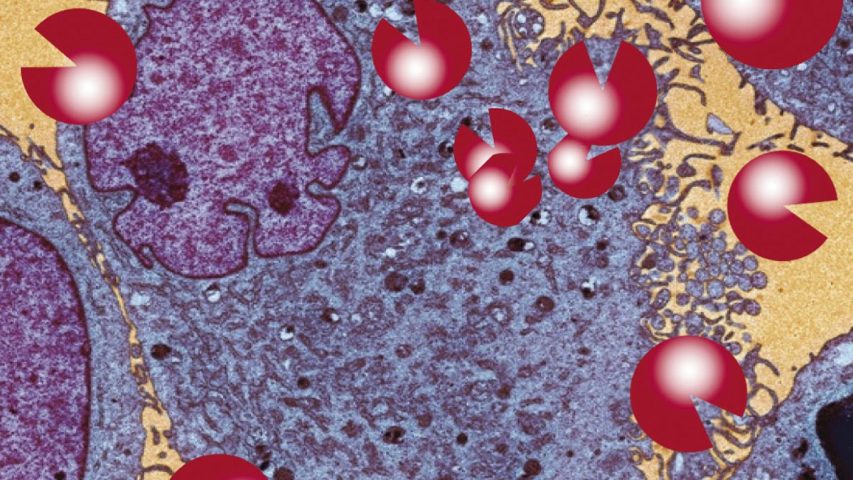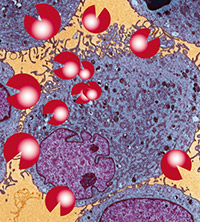- Have any questions? Contact us!
- info@dr-rath-foundation.org

The Role of Micronutrients in reducing Growth and Spread of Lymphoma
October 4, 2017
Bone Cancer responds to Micronutrient Synergy
October 4, 2017Superiority of Micronutrient Synergy in Leukemia


Leukemia cells under a highly magnifying electron microscope. The continuous secretion of collagen-digesting enzymes is illustrated by red “pacmen”. For more information on this process, please refer to the book “Victory Over Cancer”.
Leukemia is a cancer of the bone marrow, which produces blood cells. Patients with leukemia experience an excessive production of white blood cells (WBCs), also known as leukocytes. It is the tenth most commonly diagnosed cancer in the US and the most common cancer in children. In the US, approximately 52,380 people are expected to be diagnosed with leukemia in 2014. The numbers are equally staggering in Europe with 82,329 cases. Asia reported 167,448 cases of leukemia in 2012. Leukemias are largely divided into acute (rapidly progressing), chronic (slower progression), myeloid, and lymphoid types, depending on the kind of cells affected (AML, ALL, CML, CLL). The most common type of leukemia in children is ALL; in adults it is AML, CML and CLL.
We studied the effects of different individual micronutrients, as well as their specific combination, on HTLV-1 dependent leukemia cells. We demonstrated that, when used alone, vitamin C was able to reduce the cancerous cell growth and induce cell death by modifying the activity of cancer promoting specific genes1. Lysine was able to reduce the secretion and activity of MMP enzymes in HTLV-1 induced leukemia cells2. Similarly, green tea extract could trigger cell death and reduce the destructive actions of MMP enzymes3.
In our latest study4 we tested a combination of vitamin C, lysine, proline, green tea extract, arginine and other micronutrients in leukemia. This combination was markedly more effective than its individual ingredients and, even at its lowest used concentration, showed its inhibitory effect on the MMPs at key cellular levels: their production, secretion, and activity. The inhibition of MMP enzymes reached almost 100% at maximum micronutrient concentration.
Currently, more than 30 drugs are available for the treatment of leukemia. Since November 2013, the US Food and Drug Administration has approved three anti-leukemic drugs. Nevertheless, one person in the US dies from a blood cancer approximately every 10 minutes. Our research proves that this combination of safe and effective micronutrients is successful in modifying all aspects of leukemia and should therefore be considered by blood cancer patients worldwide.
Ref:
- Harakeh S, et al, Anticancer Res. 2007 Jan-Feb;27(1A):289-98.
- Harakeh S, et al, Chem Biol Interact. 2006 Dec 1;164(1-2):102-14.
- Harakeh S, et al, Asian Pac J Cancer Prev. 2014;15(3):1219-25.
- Harakeh S, et al, Int J Oncol. 2014 Nov;45(5):2159-66. Epub 2014 Sep 3.



